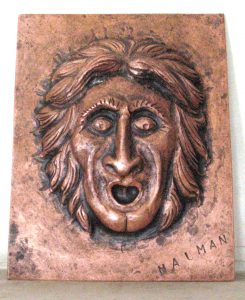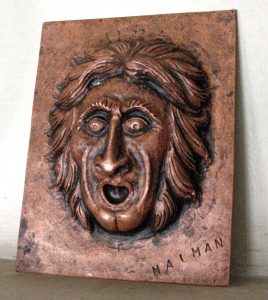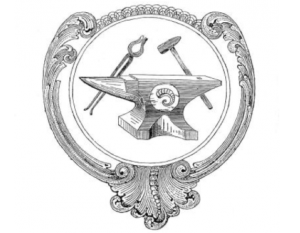Copper Repoussé, Using the “Pitch” Method

“Jacob Marley“; 4″ x 5”, 16 gauge copper, wax finish.
The above image is of a copper face that I completed yesterday, using the “pitch” method of repoussé. Some folks refer to this process as “high relief chasing.”
In April of this year, Tom Latané of T+C Latané, Pepin, WI, came to my shop to guide me through this process. We worked over a four day period. Tom worked on a bust, then I applied what I had learned to my own bust.
The piece shown above was my first solo piece since Tom was here.
Below is a side shot of “Jacob Marley.”

Below is the piece I made with under the tutelage of Tom, which is of a Fawn.

“Fawn“, 6″ x 7”, 16 gauge copper, wax finish.
Below is the face (bust) that Tom Latané made while instructing me. (He made many faces, but……that’s another story.)

“Copper Bust” by Tom Latané, 6″ x7″, 16 gauge copper, wax finish.
This method is some of the fussiest metalwork that I have ever studied, but also very satisfying. Many small punches were made to form these pieces.
Thank you Tom, for introducing me to this fine aspect of metalwork.
……..Dan Nauman
“Practice makes permanent!” ….Heidi Bernard, Saxaphone Teacher, Las Vegas, Nevada

No comment to “Copper Repoussé, Using the “Pitch” Method”
Travis Fleming - January 8, 2010
Dan, Really like your site here, very interesting information. On these copper repousses, do you draw the patterns or where do you get them?
bighornforge - January 8, 2010
Hello Travis,
I have referred to a book by Henry Rene’ D’Allemagne entitled “Decorative Antique Ironwork” (Dover Publications) for some ideas for designs. I do not always try to follow a design in the book exactly, as I want to put an empahasis on what I want the “thing” to be. Initially, I draw the design on the copper (or steel) with a fine point felt-tip marker, then make tool marks that can be followed once the ink lines disappear. I ocassionally redraw specific details such as the eyes so I am on target with the tooling.
Once you get a feel for repousse’, whether it be the pitch method, sinking, or the French method (hammer and stake), you will learn to design your own patterns, or modify existing patterns to suit your taste or the style at hand. It is like anything else…one learns by imitation, as we did as a child. Then at some point, we decide to go off on our own to explore new territory. Good luck!
……..Dan
Travis Fleming - January 8, 2010
Thanks Dan, I do have the book you mentioned. I have been doing some chase work after seeing Ernie Dorrill demo, and will be taking a class from him in November. If I knew how to do it from here I would send you some pictures of what I have done after being inspired by Ernie.